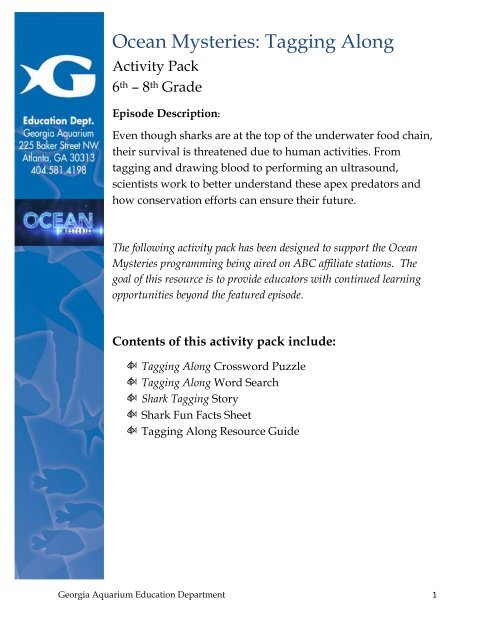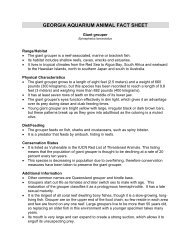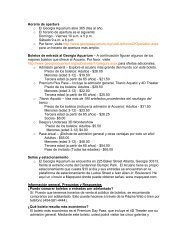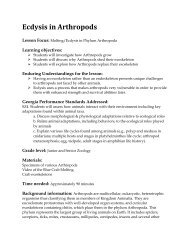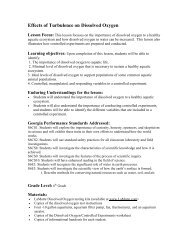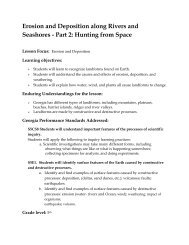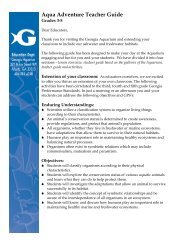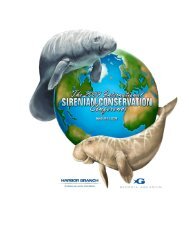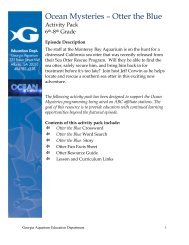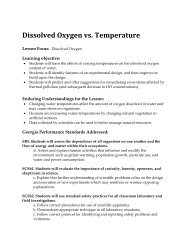download activity guide grades 6-8 - Georgia Aquarium
download activity guide grades 6-8 - Georgia Aquarium
download activity guide grades 6-8 - Georgia Aquarium
Create successful ePaper yourself
Turn your PDF publications into a flip-book with our unique Google optimized e-Paper software.
Ocean Mysteries: Tagging AlongActivity Pack6 th – 8 th GradeEpisode Description:Even though sharks are at the top of the underwater food chain,their survival is threatened due to human activities. Fromtagging and drawing blood to performing an ultrasound,scientists work to better understand these apex predators andhow conservation efforts can ensure their future.The following <strong>activity</strong> pack has been designed to support the OceanMysteries programming being aired on ABC affiliate stations. Thegoal of this resource is to provide educators with continued learningopportunities beyond the featured episode.Contents of this <strong>activity</strong> pack include:Tagging Along Crossword PuzzleTagging Along Word SearchShark Tagging StoryShark Fun Facts SheetTagging Along Resource Guide<strong>Georgia</strong> <strong>Aquarium</strong> Education Department 1
Tagging Along CrosswordStudent SheetAcross4. _____________ sharks get their name from the spots on their bodies that resemblemilitary uniforms.5. Sharks and rays are members of the classification class Elasmobranchii and have__________ systems made of cartilage instead of hard bones.6. Shining a light through an egg to see the baby inside is called _________.7. __________ are baited with pieces of fish on many hooks and are used to catch sharks.Down1. _______ sharks get their name from the unique black and white striped pattern thatthey are born with.2. _______ blood cells help to fight infection and can be counted to determine the healthof an animal.3. Blood gas pH is measured in samples taken from sharks in order to determine_________ levels.4. Oviparous animals have eggs that hatch __________.<strong>Georgia</strong> <strong>Aquarium</strong> Education Department 2
Tagging Along CrosswordAnswer KeyAcross4. Epaulette5. Skeletal6. Candling7. LonglinesDown1. Zebra2. White3. Stress4. Externally<strong>Georgia</strong> <strong>Aquarium</strong> Education Department 3
Tagging Along Word SearchStudent SheetD B L F S V J C P Y O O G I UX O I B R A H G N D V Y N T BN N X P G U G S L I B Q I Q OJ N Y H B P T D P M R B L O YE E L B X B U A O N A R D A FN T Q D J W R M I O Z H N Z SA H P S O O I I P X L E A H FC E I Y U H A L G K S B C Z CU A V S S S P O I O I I Y Q TT D E T T E L U A P E N W O KE L A S M O B R A N C H B R ZE I B B O R Z W N A N P A A SM L G O U F G C X S K H D P YP E P B X D E G T O S H B H MD W B W D M L C O F N O L A YBLOODGASCANDLINGEPAULETTEPUMPKINBAYBONNETHEADELASMOBRANCHOVIPAROUSSHARK<strong>Georgia</strong> <strong>Aquarium</strong> Education Department 4
Tagging Along Word SearchAnswer KeyD B L F S V J C P Y O O G I UX O I B R A H G N D V Y N T BN N X P G U G S L I B Q I Q OJ N Y H B P T D P M R B L O YE E L B X B U A O N A R D A FN T Q D J W R M I O Z H N Z SA H P S O O I I P X L E A H FC E I Y U H A L G K S B C Z CU A V S S S P O I O I I Y Q TT D E T T E L U A P E N W O KE L A S M O B R A N C H B R ZE I B B O R Z W N A N P A A SM L G O U F G C X S K H D P YP E P B X D E G T O S H B H MD W B W D M L C O F N O L A Y<strong>Georgia</strong> <strong>Aquarium</strong> Education Department 5
Shark Tagging Story Student Sheet 1Have students as a group or individually come up with the followingwords. Then, insert the words into the attached story and read aloud.1. Noun _____________________________2. Plural noun _____________________________3. Verb: ending in -s _____________________________4. Noun _____________________________5. Noun _____________________________6. Verb: ending in –ing _____________________________7. Plural noun _____________________________8. Noun: animal _____________________________9. Plural noun: animal _____________________________10. Noun _____________________________11. Same as 10 _____________________________12. Adjective _____________________________13. Noun: body part _____________________________14. Plural noun _____________________________15. Same as 14 _____________________________16. Verb: ending in –ed _____________________________17. Same as 14 _____________________________18. Verb: ending in –ed _____________________________19. Verb: ending in –ed _____________________________20. Noun: animal _____________________________<strong>Georgia</strong> <strong>Aquarium</strong> Education Department 6
Shark Tagging Story Student Sheet 2Shark tagging is a significant ________ in the effective monitoring of animals. Tagginghelps identify diversity of _________, health of animals, and _________ environmentalimpacts within a specified area. Tagging affords researchers insight into how abioticfactors such as habitat loss, ________, _______, and overfishing impact shark numbers.Shark _________is conducted with the use of longlines and gill nets to collect specimen.6. Verb: ending in -ingOnce a shark is caught, researchers conduct a series of _________prior to the__________being re-released. One such test, a blood lactate test, is designed to better8. Noun: animalunderstand the stress responses in wild _________by analyzing _________ draws.These __________draws specifically focus on pH and lactate levels. Research from these11. Same as 10tests will yield data such as which species are more ________to handling and whichform of collection, longline or _________nets, should be used. In addition to analyzingblood gases, sharks are suited with stainless steel ________. These ________ are_________to the dorsal fin of the shark. The size of the animal at the time of tagging as16. Verb: ending in -ed1. Noun2. Plural noun 3. Verb: ending in -s4. Noun5. Noun13. Noun: body part7. Plural noun9. Plural noun: 10. Noun12. Adjective14. Plural nounwell as the animal’s potential size is considered when determining which ________will17. Same as 14be _______. Prior to being released all sharks are ________and data such as their length,18. Verb: ending in -ed19. Verb: ending in -ed15. Same as 14weight, sex, and species are recorded. Long-term ________tagging and monitoring20. Noun: animalprograms have yielded valuable data not only in regards to best practices but have alsohelped identify new species.<strong>Georgia</strong> <strong>Aquarium</strong> Education Department 7
Shark Fun Facts SheetThere are about 400 species of sharks living today, compared to 2,000 to 3,000 inthe fossil record.Sharks are a type of cartilaginous fish, meaning their skeleton is made fromflexible cartilage (like our nose and ears) rather than solid bone.Sharks have a rough texture to their skin, similar to fine sand paper. Dermaldenticles, little tooth like structures, help sharks swim quickly and quietly andgive their skin a rough texture.Sharks have 5 to 7 gill slits. As water passes over their gills, the gills absorbdissolved oxygen to “breathe”.Some sharks lay eggs meaning they are oviparous. A shark egg cases can rangein size from 2 to 11 inches in length.Most shark species live 20 to 30 years, with the exception of the Spiny dogfishwhich may live up to 100 years!Some sharks have a nictitating membrane (clear eyelid) that covers and protectstheir eyes, like goggles, when feeding. The Great white shark does not have thisfeature and rolls its eyes back into the sockets for protection instead.When a shark loses a tooth, it is replaced by another one. This occurs throughouta shark’s lifespan allowing it to have thousands of teeth during its lifetime! Also,their teeth are not attached to their jaws. Instead, teeth are embedded in theirgums!Most sharks will eat 2-3 meals per week, while humans eat about 20! Becausesharks (like other fish) are cold-blooded, they don’t need to consume as manycalories to stay warm.Sharks have an excellent sense of hearing with ears located inside their head onboth sides rather than externally as in humans.<strong>Georgia</strong> <strong>Aquarium</strong> Education Department 8
Tagging Along Resource GuideInternet Resources:ECOCEAN Whale Shark Photo Identification Libraryhttp://www.whaleshark.org/Database for international Whale shark identification by mapping the spot patternsabove the pectoral fin.Florida Museum of Natural History Ichthyology Department: Sharkshttp://www.flmnh.ufl.edu/fish/sharks/sharks.htmNatural history articles and reports about sharks around the world.Hawaii Institute of Marine Biology: Shark and Reef Fish Researchhttp://www2.hawaii.edu/~carlm/Reports on the efforts to tag and monitor Tiger sharks off the coast of Hawaii.Mote Marine Laboratory Shark Researchhttp://www.mote.org/index.php?submenu=SCIENCE&src=gendocs&ref=SharkResearch&category=Shark ResearchFind articles, studies and more from one of the leading shark research institutes in theUnited States.Pew Charitable Trust, Global Shark Conservationhttp://www.pewenvironment.org/campaigns/global-sharkconservation/id/8589941059-Insight into conservation efforts worldwide.ReefQuest Centre for Shark Researchhttp://www.elasmo-research.org/index.htmlA blog-style website reporting on elasmobranches biodiversity. Great informationabout sharks and their threats.Shark Research Institutehttp://www.sharks.org/Information about conservation and legislation regarding sharks.<strong>Georgia</strong> <strong>Aquarium</strong> Education Department 9


